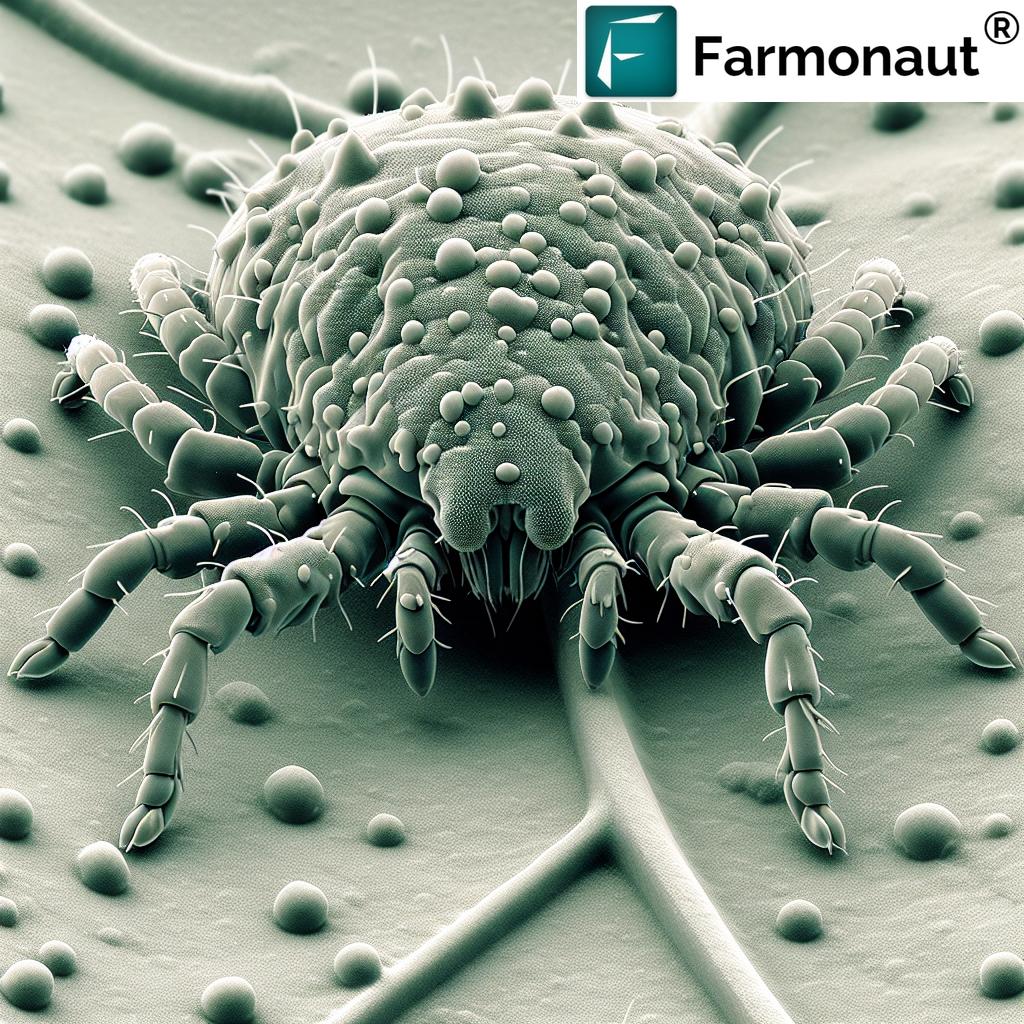Black Aphid Control: 7 Powerful Tech Strategies for Crops
“Over 4,000 aphid species exist, but just a few cause 80% of crop damage worldwide.”
Table of Contents
- Introduction
- What Are Black Aphids? Identification and Impact
- Integrated Pest Management for Aphids: The Foundation
- 7 Powerful Tech Strategies for Black Aphid Control
- Strategy Comparison Table
- Farmonaut: Cutting-Edge Agri-Tech Solutions
- Prevention of Aphid Infestations: Best Practices
- FAQ: Black Aphid Control & Tech Integration
- Conclusion & Key Takeaways
Introduction: Why Black Aphid Control Matters in Modern Agriculture
Black aphids—such as the infamous black bean aphid (Aphis fabae)—present a significant threat to crop health, agricultural yields, and even forest ecosystems. Their ability to rapidly reproduce and wide host range allows them to infest a broad variety of plants, from beans and sugar beets to celery, woody shrubs, and crops throughout global farming and forestry systems.
As we move toward sustainable, tech-driven agriculture, black aphid control becomes both a science and an art—balancing integrated pest management (IPM), cultural, biological, chemical, and physical approaches, now enhanced by technological leaps. In this comprehensive guide, we’ll examine “black aphid control” strategies leveraging technology, smart monitoring, and IPM for 21st-century farming, forestry, and agribusiness.
What Are Black Aphids? Identification and Impact
Aphid Species, Biology, and Plant Infestation Damage
Aphids are small, soft-bodied insects that feed using piercing-sucking mouthparts, extracting vital sap from a plant’s vascular system.
- Identification: Typically shiny black (adult black bean aphids), nymphs appear slate gray.
- Key Aphid Hosts: Beans, sugar beets, celery, spinach, potatoes, woody shrubs, and several forest tree species.
- Rapid Reproduction: Aphid populations can expand exponentially, giving rise to massive infestations.
Impact of Aphids on Crops and Forest Health
- Stunted Growth:
Aphids drain nutrients directly from the plant, causing reduced vigor, yellowing, and shorter stems. - Leaf and Stem Distortion:
Aphid feeding leads to curled, distorted, or spotted leaves—compromising photosynthesis and overall crop performance. - Transmission of Plant Viruses:
Aphids are vectors for numerous plant viruses, accelerating disease spread and compounding total crop losses. - Sooty Mold Development:
Honeydew excreted by aphids attracts molds, which coat leaves and impede sunlight, stunting growth further.
Understanding these effects is critical for effective aphid infestation management across agriculture, farming, and forestry. Now, let’s examine how innovative controls can halt the spread and protect yields.
Integrated Pest Management for Aphids: The Foundation
A truly comprehensive approach to black aphid control requires that we integrate many strategies—cultural, biological, chemical, and physical—now further empowered by advanced technologies for monitoring and data-driven interventions.
Key Pillars of Effective Aphid Control
- Cultural Control: Rotating crops, intercropping, optimizing plant spacing, and weed management to disrupt aphid life cycles.
- Biological Control: Encouraging or releasing natural predators such as ladybugs and lacewings, or applying entomopathogenic fungi.
- Chemical Control: Use of selective insecticides, insecticidal soaps and oils (e.g. neem), and pesticide rotation to reduce resistance.
- Physical Control: Water sprays, sticky traps, and removal of infested plant material to physically reduce aphid populations.
7 Powerful Tech Strategies for Black Aphid Control
With the evolution of precision agriculture, farmers now have access to unprecedented tools for monitoring crop health for pest detection, early warning, and targeted intervention. Let’s break down the seven most powerful, tech-driven aphid management strategies available today.
“Tech-driven monitoring can detect black aphid infestations up to 60% faster than traditional scouting methods.”
1. Satellite-Based Crop Health Monitoring
- Technology: Multispectral satellite imagery provides up-to-date field data, detecting hotspots of aphid stress and indirect signs such as reduced photosynthesis or abnormal leaf color.
- Farmonaut Solution: Farmonaut’s satellite-based farm management tools allow growers to monitor vegetation health, soil moisture, and the spatial spread of pests, helping allocate resources and scouts efficiently.
- Outcome: Early detection of aphid outbreaks, reducing risk and cost of delayed intervention. See detailed tips here.
2. AI-Powered Pest Prediction & Advisory
- Technology: Machine learning and AI-based advisory systems aggregate historical aphid data, weather patterns, and satellite signals.
-
Farmonaut Solution:
Our Jeevn AI Advisory System delivers field-specific, real-time recommendations on aphid risk and best practices for management—explore in our application. - Use Case: Forecast aphid outbreaks, optimize timing of cultural or chemical controls (see API developer docs for integration).
3. Remote Sensing for Pest Hotspot Mapping
- Technology: Remote sensors (drone, IoT, and satellite) pinpoint regions in the field where aphids cluster, enabling “smart scouting.”
- Farmonaut Solution: Fine-tuned NDVI maps on the Farmonaut platform reveal subtle differences in plant health linked to aphid infestations—perfect for tighter interventions.
- Practical Impact: Direct scouting teams, drones, or sprays only to affected zones, reducing total pesticide application.
4. Precision Application of Insecticides and Biopesticides
- Technology: GPS-guided tractors, smart sprayers, and drone technologies allow selective targeting of aphid hotspots.
- Outcome: Reduce chemical input costs, lower environmental impact, and help prevent aphid resistance to pesticides.
- Integration: By leveraging Farmonaut’s monitoring data, growers can program machinery to treat only zones that need it. Review our API for integration.
5. Blockchain Traceability for Crop Protection Inputs
- Technology: Blockchain ensures traceability in pesticide application, biocontrol use, and pest events, helping verify adherence to safe, legal, and sustainable pest management protocols.
- Farmonaut Solution: Our blockchain-based traceability solution brings transparency and trust to supply chains—critical for export compliance and consumer reassurance. Document each aphid intervention securely.
- Value: Improved market access, easier auditing for pesticide logs, and fraud prevention.
6. Data Analytics for Resistance Management
- Technology: Aggregating aphid monitoring data, insecticide application logs, and outcome metrics to refine integrated pest management strategies.
- Farmonaut Solution: Multi-year datasets highlight which aphid control methods work best for a given crop, climate, and region. Historical analytics also help guide pesticide rotation schedules for resistance prevention.
- Practical Impact: Optimize your aphid management by combining big data analytics with local insights.
7. Digital Advisory, Alerts, and Knowledge Sharing
- Technology: Mobile apps, web dashboards, and SMS/email push notifications deliver tailored pest alerts and “how to get rid of aphids on plants” advice to your phone.
- Farmonaut Solution: All-in-one access via Android, iOS, and web—get local risk maps, management tips, and the latest tech-driven ideas for aphid suppression. Try our platform here!
- Outcome: Breaks down the barriers to knowledge, ensuring even smallholder and remote farmers benefit from modern aphid management.
Strategy Comparison Table: Tech-Driven Black Aphid Control
| Strategy Name | Technology Used | Estimated Effectiveness (% pop. reduction) | Cost Range (per acre) | Implementation Complexity | Preventive or Reactive | Key Benefits |
|---|---|---|---|---|---|---|
| Satellite-Based Monitoring | Multispectral satellite imagery, NDVI | 30–70% | $2–$15 | Easy | Preventive |
|
| AI Advisory & Pest Prediction | Machine learning, weather analysis | 35–65% | $5–$12 | Moderate | Preventive |
|
| Remote Sensing Hotspot Mapping | Drones, satellite/IoT sensors | 40–75% | $8–$35 | Moderate | Reactive |
|
| Precision Application Tech | GPS-guided sprayers/drones | 50–80% | $12–$60 | Advanced | Reactive |
|
| Blockchain Traceability | Distributed ledger systems | 20–45% | $1–$8 | Moderate | Both |
|
| Data Analytics for Resistance Mgmt | Big data platforms | 20–50% | $2–$10 | Moderate | Preventive |
|
| Digital Advisory & Alerts | Mobile/web apps, SMS/email | 15–40% | $1–$9 | Easy | Preventive |
|
Farmonaut: Cutting-Edge Agri-Tech Solutions for Aphid Control
At Farmonaut, our mission is to democratize precision agriculture so that farmers, agribusinesses, and policymakers can harness the power of satellite, AI, and blockchain technologies for smarter black aphid control and integrated pest management.
- Affordable, On-Demand Satellite Crop Health Monitoring—No hardware required. Receive crop health maps, soil moisture levels, and early warning for aphid outbreaks from anywhere via our browser or mobile app.
- Customizable AI Advisories—Get personalized advice, based on satellite and weather data, to optimize aphid management, fertilizer scheduling, and resource allocation.
- Blockchain Traceability—Ensure your crop protection input traceability and compliance with export regulations by documenting every step of your pest management process.
- Resource & Fleet Management—Leverage our fleet management dashboard to optimize machinery scheduling, spray routes, and pesticide transport—saving costs on every acre.
- Carbon Footprinting—Map the carbon footprint of your pest management practices. Sustainable aphid control can protect yields and the planet.
- Crop Plantation & Forest Advisory—Use our forest and plantation-oriented app tools to prevent black aphid spread in tree nurseries and agroforestry landscapes.
- Insurance & Credit Verification—With satellite-verified insurance, benefit from faster claim validation and real aphid-damage tracking for smarter lending decisions.
- API Integration for Developers—Want to build your own tools or integrate satellite aphid monitoring into existing farm management software? Get started with our API and Developer Docs.
Prevention of Aphid Infestations: Best Practices and Cultural Methods
Technology alone is not enough. Long-term aphid and pest pressure must be mitigated by implementing strong preventive strategies—many of which are enabled and optimized by Farmonaut’s tech, but rooted in proven agronomic principles.
Cultural Methods for Pest Control
- Crop Rotation: Changing crops every season disrupts aphid life cycles and reduces host plant availability. For example, avoid back-to-back planting of beans or sugar beets in the same field.
- Intercropping & Companion Planting: Certain crops can repel aphids (e.g. onions, garlic with beans), attract beneficial insect predators, or “confuse” pests through plant diversity.
- Proper Plant Spacing: Ensures good airflow, reducing aphid colonization and the spread of viruses among closely-packed leaves.
- Weed Control: Weeds often act as alternate aphid hosts. Maintain clean fields to starve populations outside of the main crop.
Biological Control of Aphids: Harnessing Nature’s Defenders
- Encouraging Beneficial Predators: Ladybirds, lacewing larvae, hoverfly larvae, and parasitoid wasps all consume aphids and suppress populations naturally.
- Releasing Biocontrol Agents: Commercial releases of predators or entomopathogenic fungi like, Beauveria bassiana bring immediate, eco-friendly control.
- Controlling Ants: Ants “farm” aphids for honeydew, protecting them from predators; manage ants to allow natural aphid enemies to thrive.
Physical and Chemical Approaches: Tools & Traps
- Water Sprays: A strong jet can knock aphids off stems, reducing numbers for small-scale infestations.
- Sticky Traps: Yellow sticky cards catch flying aphids—ideal for monitoring both infestation levels and population trends.
- Pruning & Removal: Promptly clip and destroy highly infested plant parts to curb spread and virus transmission.
- Insecticidal Soaps & Oils: Products like neem or potassium salts disrupt pests but spare many beneficial insects. Rotate these with other control products to prevent resistance.
Implementing Monitoring for Early Detection
Effective monitoring is the cornerstone of IPM—and now can be achieved digitally:
- Regular Field Scouting: Check undersides of leaves and new growth, especially early in the season.
- Satellite & Drone Surveillance: Detect subtle crop stress patterns invisible to the naked eye.
- Monitor for Virus Symptoms: Some aphids transmit viruses even at low population levels.
For more on digital tools and scouting guides, view our detailed university extension resources.
Protecting Seedlings & Reducing Initial Population Build-Up
- Use Row Covers: Physical row covers (spunbond fleece or nets) shield young plants from colonization.
- Plant Health Management: Avoid over-fertilizing with nitrogen—a lush, soft plant is more attractive and vulnerable to aphids.
For scalable, data-driven aphid management, use Farmonaut’s API and explore our Developer Docs to integrate satellite-based pest monitoring directly into custom farm management software or agribusiness operations.
FAQ: Black Aphid Control & Tech Integration
Q1: What is the most effective way to get rid of aphids on plants?
Combining early detection (via satellite or regular scouting) with cultural, biological, and targeted chemical controls is the gold standard for “how to get rid of aphids on plants.” For severe infestations, targeted insecticides or biocontrol releases are recommended. Always prioritize IPM and sustainable practices.
Q2: How does technology improve aphid infestation management?
Tech tools (like Farmonaut’s platform) detect infestations earlier, allow data-driven responses, optimize spray applications, and help manage interventions with traceability and resistance analytics. This improves yield, saves inputs, and reduces environmental impact.
Q3: Is biological control of aphids practical for large-scale farms?
Yes. Augmenting natural predators or applying fungal biopesticides can work at scale, especially when combined with remote sensing for hotspot detection and targeted release. It’s especially powerful in integrated pest management programs.
Q4: How do I prevent aphid resistance to insecticides?
Regularly rotate between different classes of insecticides, employ non-chemical approaches, and use AI/data analytics to avoid unnecessary chemical use. Integrated pest management for aphids helps reduce resistance risks.
Q5: Can Farmonaut’s tools be used in forestry or just in crop agriculture?
Our digital advisory and satellite monitoring are effective in crop, plantation, and forest management—helping detect aphid hotspots in woody species and monitoring tree health in both commercial and conservation forestry.
Q6: Are sticky traps and row covers still effective in high-tech farming?
Absolutely. Physical measures like sticky traps and row covers are foundational and become even more strategic when informed by technology (e.g., knowing when/where to deploy based on remote sensing).
Conclusion & Key Takeaways for Black Aphid Control in Agriculture, Farming, and Forestry
Black aphid control is most successful when integrated pest management strategies are reinforced by the latest technologies—satellite monitoring, AI-driven advisories, precision application, data analytics, and digital traceability. Preventing and managing aphid damage is no longer guesswork; it’s about combining traditional knowledge with real-time, data-driven decision making.
- Adopt a holistic approach: Use cultural, biological, chemical, and physical methods in concert—supported by technology for monitoring, alerts, and record-keeping.
- Embrace innovation: Incorporate satellite crop health data, AI-powered pest forecasts, and targeted application tools to reduce overall input costs and maximize yields.
- Stay connected: Farmonaut’s subscription-based platforms make precision aphid management affordable and accessible—for individual farmers, agribusinesses, and government users alike.
- Think preventively: Healthy plants, clean fields, wise scouting, and timely interventions will minimize aphid outbreaks and support strong, sustainable harvests.
By leveraging these tech-driven strategies for black aphid control, we build resilient, sustainable, and profitable agriculture for the future.
Further Reading: For complete guides on aphid-specific tech solutions and integrated farm management, visit our blog.













